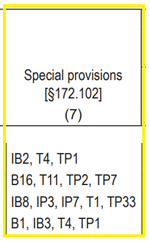How to Use US DOT's Hazmat Special Provisions
US DOT’s Hazardous Materials Regulations (HMR) list more than 3,000 shipping names for regulated materials—from acetal to zirconium tetrachloride.
Each of those shipping names is assigned at least one packaging instruction (PI), indicated in Column 8 of the Hazardous Materials Table in 49 CFR 172.101. In general, packaging instructions tell shippers what types of packagings—fiberboard boxes, plastic bottles, steel drums, etc.— may be used to offer their material in a bulk, non-bulk, or limited quantity.
There are far fewer packaging instructions than there are shipping names in the regulations. As a result, hundreds of different hazardous materials may be assigned to the same PI.
This is what makes hazmat “special provisions” essential, and why most hazardous materials are associated with at least one special provision. Special provisions provide additional details—and often extra restrictions—that shippers must comply with to ship a specific hazardous material.
Where to Find Hazmat Special Provisions
Column 7 of the 172.101 Hazmat Table lists the special provisions that apply to an individual proper shipping name. Each special provision is indicated using a numeric or alphanumeric code. All special provisions are listed by their code in 49 CFR 172.102.
To comply with the regulations and safely ship any hazardous material, the shipper must use both the packaging instruction and all applicable special provisions to prepare the shipment.
 Excerpt from Lion's 49 CFR Hazardous Materials Regulations (HMR) ©
Excerpt from Lion's 49 CFR Hazardous Materials Regulations (HMR) ©
Guide to Hazmat Special Provision Codes
 How does the shipper know which special provisions apply to their hazmat shipment? Special provisions are written in “code.” When you know the code, it’s easier to identify the special provisions that affect your shipment.
How does the shipper know which special provisions apply to their hazmat shipment? Special provisions are written in “code.” When you know the code, it’s easier to identify the special provisions that affect your shipment.
Numeric Codes. The most broadly applicable special provision codes are “numeric”—they contain numbers only (i.e., “16”). These codes apply to all modes of transportation and may apply to bulk or non-bulk packagings. In other words, these numbers-only codes can apply to any shipment of the hazardous material.
Alphanumeric Codes. All other special provisions codes are alphanumeric—they consist of a letter followed by a number or numbers. The letter(s) contained in a special provision code tells us which mode of transportation or type of packaging the provision applies to.
Mode of transportation:
- “A” codes apply only to air transportation
- “R” codes apply only to rail transportation
- “W” codes apply only to transportation by water
Type of packaging:
- “N” codes apply only to non-bulk packaging requirements
- “B” codes apply to only to bulk packaging requirements (except IBCs and tanks)
- “IB” and “IP” codes apply only to transportation in Intermediate Bulk Containers (IBCs)
- “T” or “TP” codes apply only to transportation in portable tanks
(For more details, see 49 CFR 172.102(b))
Why Hazmat Special Provisions are Essential
Here’s is one (very simplified) example of what makes special provisions so important:
One of the packaging instructions used to prepare non-bulk shipments of sulfuric acid (UN 1831) states that authorized packagings include steel drums, aluminum drums, and many others.
However, sulfuric acid reacts with aluminum in a way that has potential to create a hazardous situation. For this reason, sulfuric acid is also assigned special provision N34. Special provision N34 tells the shipper that this material may not come in contact with aluminum packagings.
So, even though the packaging instruction lists aluminum as a potential choice—the special provision tells the shipper that, for this specific material, aluminum is not authorized.
Overlooking a special provision that applies to a material or package can lead to an accidental release in transportation, a violent chemical reaction, or worse. Hazardous materials shippers must identify and properly apply these provisions to ensure every shipment reaches its destination safely.

Hazmat Shipper Certification Training
Locating and applying applicable special provisions is one of the many crucial skills attendees develop at Lion’s hazmat shipper workshops. The 2023 schedule of in-person training is available now for open enrollment.
For live, instructor-led webinar training, Lion will present the Hazmat Ground Shipper Certification (DOT) Webinar two more times in 2022.
Or train at your own pace with interactive online courses for ground, air, and vessel shippers. Browse all 49 CFR, IATA DGR, and IMDG Code courses at Lion.com/Hazmat.
Find a Post
Recent Posts
Compliance Archives
Download Our Latest Whitepaper
Four key considerations to help you maximize the convenience and quality of your experience with online training.

By submitting your phone number, you agree to receive recurring marketing and training text messages. Consent to receive text messages is not required for any purchases. Text STOP at any time to cancel. Message and data rates may apply. View our Terms & Conditions and Privacy Policy.
